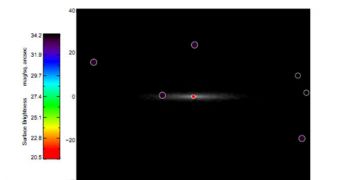According to a mounting body of evidence, it would appear that our galaxy may have collided with a large black hole as little as 10 million years ago. The object was most likely located at the core of a smaller, dwarf galaxy as the event happened.
This theory was extrapolated from a number of sources, studies conducted on the center of our galaxy over the past few years. There are numerous clues available to indicate that the core of the Milky Way was recently a lot more active than it is today.
At the same time, it's known that our home collided with numerous dwarf galaxies in the past, accreting their matter and triggering new ages of stellar formation. It is also known that the galaxy may be surrounded by small counterparts, that have yet to be detected.
One of the most interesting aspects of our galactic core is the fact that two massive bubbles of gamma-ray-emitting gas are located near the supermassive black hole powering up the Milky Way. These clouds extend outwards by as much as 20 kiloparsecs.
These structures, called Fermi Bubbles, emerged in a manner that astrophysicists cannot yet explain. The most interesting thing about them is that they resemble structures that astronomers are seeing in distant objects called active galactic nuclei (AGN).
Then there is the issue of old stars at the core of our galaxy. While elsewhere they abound, they mysteriously disappear when you get close to the black hole. Their place is taken by tens of thousands of new, blue stars, which are produced in three massive stellar nurseries near the core.
This should also be impossible, as a dark behemoth the size of the one powering the Milky Way should exert such a strong gravitational pull that all hydrogen gas clouds should be disintegrated, Technology Review reports.
Advanced telescopes also noticed an unusual fluorescence coming off iron nuclei in the star-forming regions of the Milky Way. Astrophysicists say that this phenomenon was most likely caused by a very recent gamma-ray bombardment.
According to Vanderbilt University astronomer Meagan Lang, these mysteries can all be explained if we accept that a dwarf galaxy slammed into our Milky Way recently. The object brought new gas, stars, and a large black hole into the mix.
The dark behemoth, some 10,000 times more massive than the Sun, eventually collided with its supermassive counterpart at the core of the Milky Way. The two joined masses, becoming an even larger black hole. This may have happened as little as 10 million years ago.
“While the case for a merger of the Milky Way with a satellite galaxy is not ironclad, it is a plausible explanation that naturally accounts for both the old and young stellar distributions and the recent violent past of [Sagittarius] A*,” Lang says.
Sagittarius A* is the supermassive black hole at the core of the Milky Way, tipping the scale at around 4.1 million solar masses.

 14 DAY TRIAL //
14 DAY TRIAL //